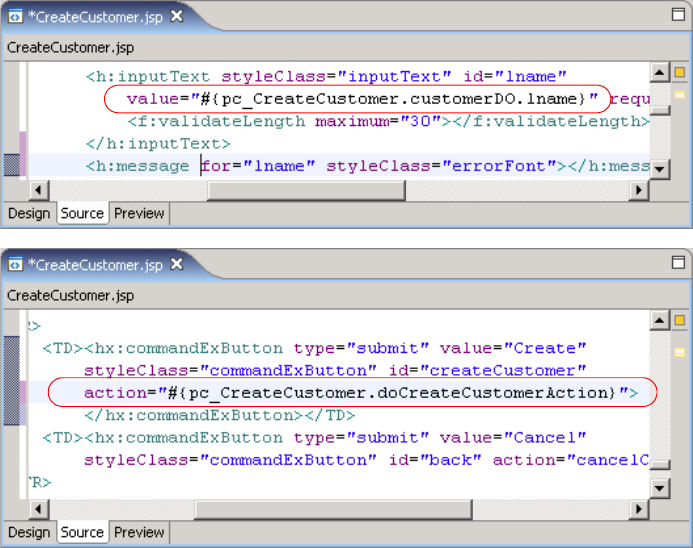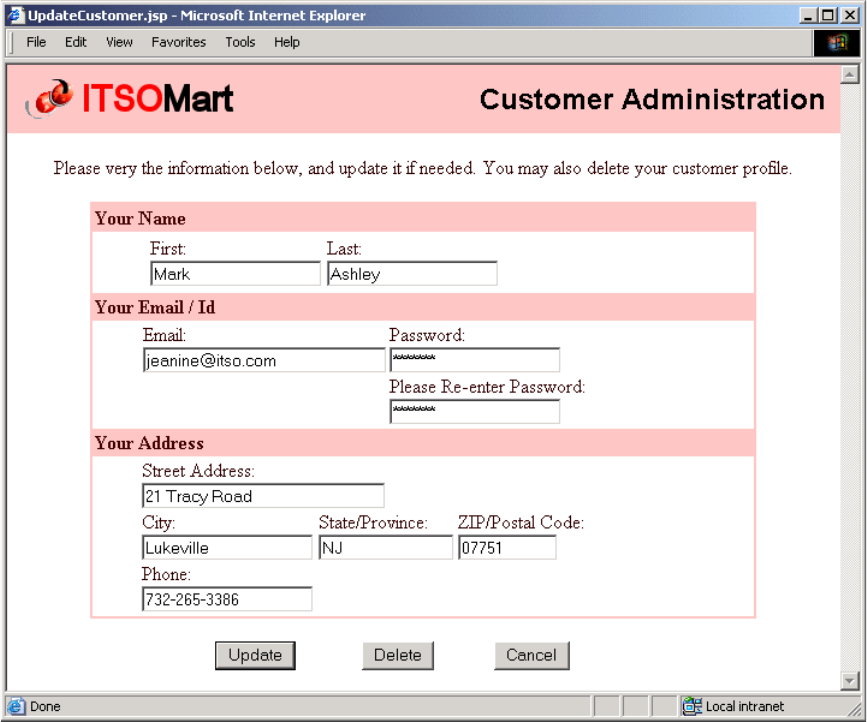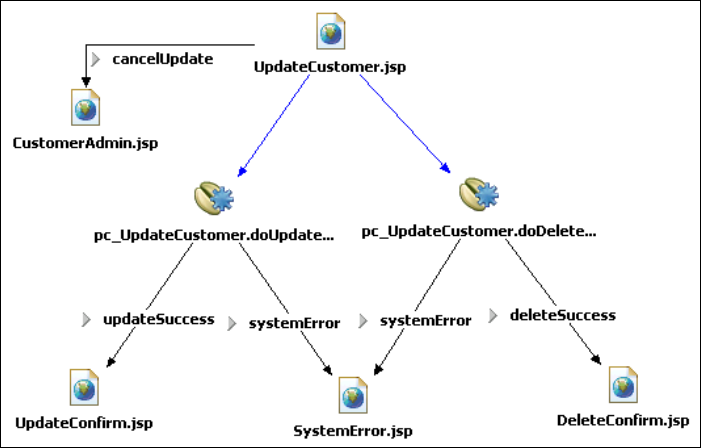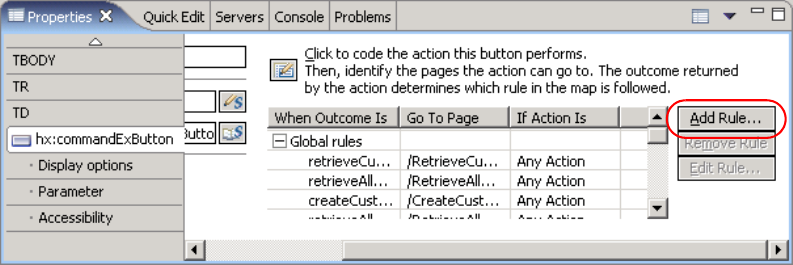
Chapter 9. JSF front-end scenario 275
Using the Source tab in the page designer, we can inspect the actual source
code of the JSP files. Figure 9-21 shows the portions of source code
corresponding to the two examples we described earlier. This is code which was
generated by Rational Software Architect based on the information we entered in
the properties window and the different wizards.
The first window shows the code binding the last name input field to the lname
field in the customerDO managed bean. The second window shows the code
binding the Create
button to the doCreateCustomerAction method in the
pc_CreateCustomer backing bean.
Figure 9-21 CreateCustomer.jsp data binding source code
9.4.5 Implementing page navigation
Section 9.3.1, “ITSOMart Web diagram” on page 253, provides a very good
overview of the page navigation in JSF, and specifically in the ITSOMart
application. This section explains the low-level details of how we use Rational
Software Architect to setup the navigation rules.
For this particular example, we depart from our usual create customer use case,
and instead look at the update customer screen. The reason is simply because

276 Patterns: Implementing Self-Service in an SOA Environment
that screen offers more possible outcomes, which makes it a more interesting
example to describe navigation. Figure 9-22 shows the ITSOMart update screen,
allowing the user to update their profile information, delete, or cancel the
operation.
Figure 9-22 Update Customer Screen
Update customer Web diagram
Section 9.3.1, “ITSOMart Web diagram” on page 253 introduces the concept of
Web diagrams. In that section however, the diagram is used to illustrate the
complete end-to-end flow of the ITSOMart application and omits such details as
the managed beans being invoked to trigger actions. Figure 9-23 on page 277
provides a more detailed Web diagram illustrating the screen flow design and
navigation for the update customer use case.

Chapter 9. JSF front-end scenario 277
Figure 9-23 Update customer Web diagram
Reading the diagram, we can infer the following information about the screen
flow of the update customer use case.
From the UpdateCustomer.jsp page, there are three possible navigation
scenarios:
– The user can trigger an action to update the profile, with the
doUpdateCustomerAction
method of the pc_UpdateCustomer backing
bean. Note that the method name is truncated by Rational Software
Architect in the Web diagram.
– The user can trigger an action to delete the profile with the doDeleteAction
method of the pc_UpdateCustomer backing bean.
– The user can cancel out of the update screen, and simply navigate back to
the home page, CustomerAdmin.jsp.
Depending on whether the update or delete actions are successful, the user
application navigates to an appropriate confirmation screen, or to a generic
system error page.
Implementing customer update navigation
Now that we understand how we want the use case to flow, we show how we
implement the flow using Rational Software Architect. We begin by setting up a
navigation rule for the Update button in the UpdateCustomer.jsp page.

278 Patterns: Implementing Self-Service in an SOA Environment
Assume that before we start, we first create an action method,
doUpdateCustomerAction, in the UpdateCustomer.java backing bean. This
method is bound to the Update button in the UpdateCustomer.jsp page, following
the steps previously described in “Binding command buttons to action methods”
on page 273. The method will return the outcome string of updateSuccess, if the
customer information is successfully updated. If there are any errors, the method
returns systemError.
Now we can add the navigation rule as follows.
1. Open UpdateCustomer.jsp in the Design tab.
2. Click the Update commandButton JSF component, which should populate
the Properties window on the bottom.
3. Scroll to the right portion of the Properties window, where you will find the
navigation rules table, as shown in Figure 9-24. Click the Add Rule button.
Figure 9-24 Navigation rules table
4. When the Add Navigation Rule wizard appears, enter the following, as shown
in Figure 9-25 on page 279:
Get Patterns: Implementing Self-Service in an SOA Environment now with the O’Reilly learning platform.
O’Reilly members experience books, live events, courses curated by job role, and more from O’Reilly and nearly 200 top publishers.

